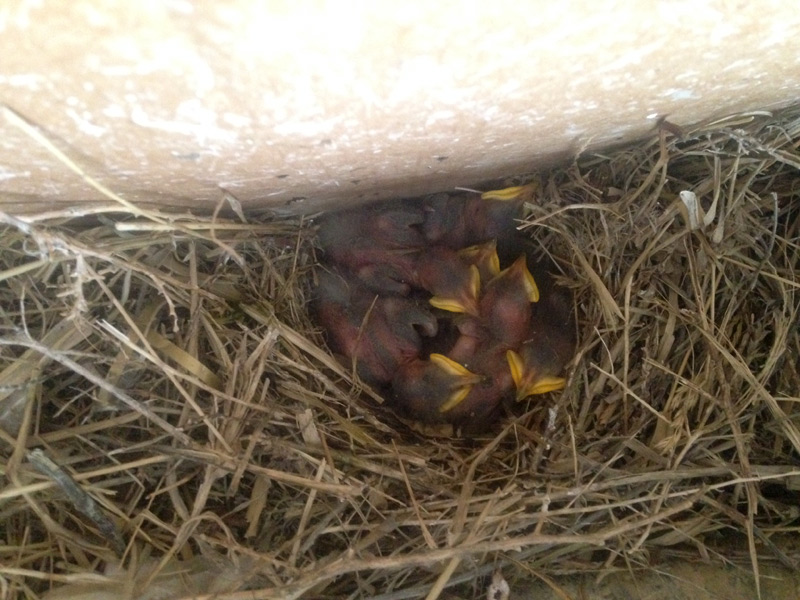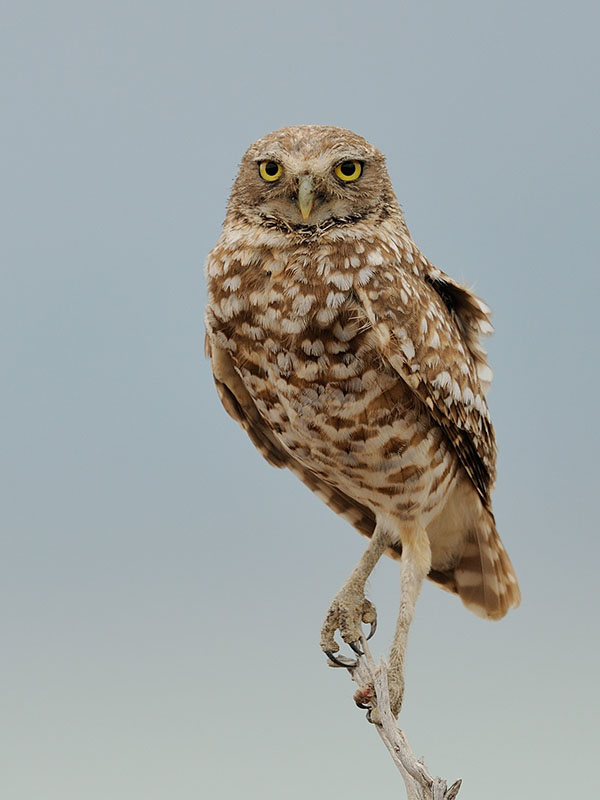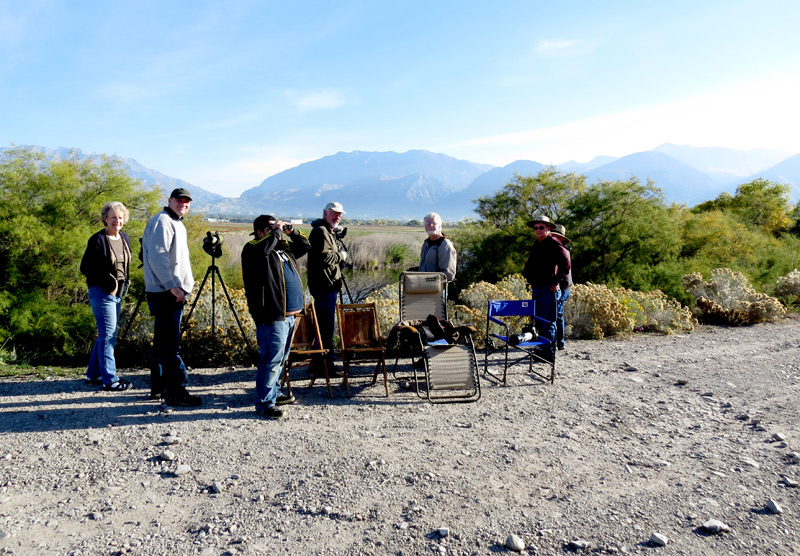Utah County Birders Newsletter
|
|||||||||||||
 |
Contents
November Meeting
Upcoming Field Trips
2014 Birding
Challenge reminder
Captain’s Log
Bird of the Month
Field Trip Report
- PAD, Big Sit
Field Trip
Report
- Payson Canyon
Backyard Bird of the Month
October Hotline Highlights
NOVEMBER MEETING:
Thursday, November 13th,
2014 - 7:00 pm
Dennis Shirley - Birds of Shemya Island.
Dennis Shirley
will be giving a presentation on his trip to Shemya Island, a small
island in the Semichi Islands chain in the Aleutian Islands archipelago
southwest of Alaska.
Meet at 7pm at the Bean Museum. Check with the information desk at the museum to
find out which room we'll be in. Probably in the same room as last month, right
behind the information desk.
8 November, 2014 (Sat).
A day trip to Beaver and Iron Counties - We
will try to knock off both counties for the UCB Challenge and explore some areas
that don't get birded too often. It will be an all day trip. Plan on meeting at
Payson Walmart (I think it is exit 248) at 6:30 AM to carpool from there. Since
we have a long drive this will be an all day trip. Leader: Bryan Shirley
801-722-9346
20 December, 2014 (Sat).
Provo Christmas Bird Count: More
details next month, but keep the date open!
3 January, 2015 (Sat).
Payson Christmas Bird Count.
We are actively recruiting people to lead local half-day field
trips, any time, any place. If you would like to lead a field trip or if you
have any ideas for this year’s field trips, please contact Bryan Shirley at -
bt_shirley@hotmail.com
Our 2014 Birding Challenge
is drawing to a close!
Please email Keeli Marvel (keeli.marvel@gmail.com) with your name and level of
the challenge achieved, if you have completed the challenge or anticipate doing
so by the end of the year so we can get an idea of the number of prizes we will
need.
Here is a link to the
2014 UCB Birding
Challenge.
Captain’s Log:
November 2014
 |
|
Starling Nest |
Bird nesting ecology
by Keeli Marvel
The diversity of site selection and nesting habits of bird species is as varied
and diverse as everything else in the bird world. Species make a living by
exploiting the available niches in their environment, and that applies to
nesting as well. Some birds nest on branches or in cavities in trees, some on
the ground, some like Burrowing Owls, Tufted Puffins, and Common Murres, nest in
burrows dug into the ground. Some birds nest in muddy river banks, or on island
sea cliffs, and some, like Black Terns, nest behind waterfalls. Gila Woodpeckers
nest in cavities inside Giant Saguaro Cactus in the southwest.
Some species nest individually, while others are colonial nesters. Most of the
heron species and many pelagic species such as kittiwakes, terns, and puffins
all nest in huge colonial groups. Some species have very specific requirements
for nesting sites. When these sites are threatened by human encroachment and
development the species does not have the ability to pick up and relocated, and
can become threatened or endangered as a result. This was the case with
old-growth-forest-nesting species Marbled Murrelets, and Spotted Owls which both
rely on big old trees to nest in/on. Other species are nesting location
generalists and will nest just about anywhere, including in other bird’s nests.
This category includes species such as the European Starling. Where I work, it’s
common to see starlings nesting in American Kestrel nest boxes, in the rafters
of open sheds, and once, even in a mechanical gate mechanism box. At work this
past spring I was called to rescue a bird nest that was in an unfortunate
location. When I got there, I found starlings nesting inside an open box next to
a motor that was due to be sent to surplus. The box was sitting in an open shed
and the starlings had decided that it was an ideal place to nest.
Bird species are very unique in the types of nests they build and the materials
they use to do so. Swallows use mud and spit to craft cup-shaped or enclosed
nests under building eaves and bridges. Tiny hummingbird and gnatcatcher species
will use spider silk to anchor their nest materials together. Weaver birds in
Africa use thin strands of leaf fiber, twigs, or grasses to weave intricate
bell-shaped or spherical woven nests. Similarly, Orioles in North America will
use vegetation to build intricate, pendulous hanging nests. Common magpies,
other corvid species, and Osprey have been known to use bailing twine, bits of
other man-made debris, and even in a few unique instances, barbed wire, in their
nest construction. Several grebe species will build their nests on the water on
floating rafts of vegetation.
In contrast, some species don’t build nests at all. Peregrine Falcons are
famously known for nesting high on cliff faces and the sides of really tall
building in stark nesting locations called “scrapes” where they use natural rock
crevices or building features for cover. Birds in the nightjar family are also
characterized by their lack of nesting material, and nest on bare ground on top
of leaf litter or in depressions shaded by vegetation. Emperor penguins, nesting
in some of the most inhospitable conditions in the world, don’t even nest at
all. Instead, the males incubate the eggs on top of their feet for over two
months while the females return to the ocean to feed. That’s dedication right
there.
As winter begins and we all snuggle down into our own nests for the holiday
season ahead, I wish you all a happy Thanksgiving, and I hope to see as many of
you as possible out for our Christmas Bird Count this year! Even if you can only
join us for a couple hours on the day of the count, the more eyes the better,
and the more the merrier! Stay tuned to our December newsletter and meeting for
more details.
Happy Birding!
 |
|
Photo by John Crawley. |
Burrowing Owl
Athene cunicularia
by Jim Strong
This is a cute, long-legged, short-tailed little owl and a thrill to see in the
wild as most birders will agree. The average adult owl is slightly larger than
the American Robin.
According to many sources, birding books and the internet these represent the
size averages for the Burrowing Owl.
Length: 9 - 11 inches
Wingspan: 20 – 24 inches
Weight: 4.9 – 8.5 ounces
Males and females are colored alike with white streaking above the eyes on the
head, white chin and throat, brown upper parts with white spotting, white to
buff underparts with brown barring. They have bright yellow eyes, round head and
no ear tufts. They inhabit open country, grasslands and prairies, and can be
found in similar habitats near humans such as golf courses and airports.
Behavior Unlike other owls the Burrowing Owl is active in daylight
hours. They can be seen daylight hours especially during the spring when they
are gathering food for their young. They can be seen near the burrow on the
ground, on a fence post and often standing on one foot. They do a lot of hunting
at dawn and dusk seeking, larger insects, grasshoppers, small mammals such as
gophers, mice, ground squirrels, and young cotton tail rabbits. Small birds like
sparrows and horned larks are likely to be on the menu. They catch what they
can, even snakes.
EYES The eyes of owls are placed close together. If you had eyes in
proportion to the size of an owl it would be as if two grapefruits were placed
in your eye sockets. An owl can look straight ahead only because its eyes are
held in place by bony elongated tubes called sclerotic rings. The pupils of an
owl’s eye can open independent of each other, thus giving the owl excellent
night vision. Owls have a third eyelid, called “nictitating membrane”, that
functions like a windshield wiper blade moistening with a tear at each blink,
and also gives added protection when the owl has to wrestle its prey.
Breeding and nesting Burrowing Owls nest underground in abandoned
burrows dug by prairie dogs, ground squirrels, badgers and even skunk holes.
They are able to dig holes or enlarge them in the softer soils. Manmade nest
boxes have been successful in some areas inclusive of Antelope Island and Salt
Creek Wildlife Management Area in northern Utah.
The nest is lined with horse and cow manure, food debris, dry grass, weeds,
pellets and feathers. It is built by both sexes but the male does more. The
female will lay and incubate 7 – 10 white eggs for 21 -30 days. They are
semialtricial and the young remain in the nest about 28 days. They are fed by
both parents. One to two broods a year is typical depending on food sources.
Nesting season begins in late March or April. Courtship displays include
flashing white markings, cooing, bowing, scratching and nipping. The male
performs the aerial displays. Often the outside of the burrow on the mound may
be lined with animal dung to attract certain beetles which also serves as food
for the owl family. They also have a curious habit of decorating the burrow
entrance with shiny objects. One or more “satellite” burrows can usually be
found near the nest and are used by adult males during the nesting period and by
juvenile owls for a few weeks after they emerge from the nest.
Mortality Burrowing Owls are able to live up to nine years in the
wild and in captivity they can live 10 or more years. They are often killed by
vehicles as they cross roads in flight. They have many natural enemies such as
Great Horned Owls, hawks, falcons, badgers, skunks, foxes, coyote, snakes and
some domestic cats and dogs. Indications that they are declining are due to
poison-control programs aimed at prairie dogs and ground squirrels and habitat
loss.
Good birding locations for the Burrowing Owl in Utah
1. The closest area is the west side of Utah lake and above Saratoga
Springs
2. Deseret Land and Livestock
3. Antelope Island
4. Pony Express Trail near and west of Simpson Springs
Sources: Smithsonian Handbook BIRDS OF NORTH AMERICA, Field Guide of
Birds, Western Region by Donald & Lillian Stokes, Bill Fenimore, iBird and the
National Wildlife Federation.
If you would like to
write an article for the Bird of the Month, please contact
Machelle -
machelle13johnson@yahoo.com
Click here for past 'Birds of the Month'.
Field Trip Report
Provo Airport Dike Big Sit!
- 11 October 2014
by Eric Huish
 |
|
Big Sitters Standing in the Sit Circle. |
On a
Big Sit you pick a spot and spend the day sitting within a 17 foot circle and
only count birds you see from that one spot. Many people across the country
participate in 'The Big Sit!' on the second weekend of October every year.
This year's Provo Airport Dike Big Sit was covered continuously from 6:09 am to
6:20 pm. (12 Hours 11 Minutes). We sat at the Southwest Corner of the dike loop.
The weather was nice and we had several birders out helping us count but for
some reason this year we only saw 45 species, one of our lowest counts in the 13
years we've done the big sit. Last year we sat at the same spot and got our
record count (61 species). We didn't get any sit lifers this year, our 13 year
(13 day) Big Sit Life List is still at 117 species. A Great Horned Owl and
Mountain Chickadee were seen from the sit spot the day before but couldn't be
found on the day of.
Sit Participants - Keeli Marvel, Carlos Caceres, John Crawley, Milt Moody, Alona
Huffaker, Robert Brown, Yvonne Carter, Larry Reeves, Cliff Miles, Jim Strong,
Kay Stone, Jason Lane, Kathleen Blanchard, Alton Thygerson, Suzi Holt, Amanda
Holt, Carol Nelson and Eric Huish.
I would like to especially thank Keeli Marvel, Carlos Caseres and John Crawley
for volunteering to lead the sit on the afternoon and evening shifts.
If you'd like to know more about the Big Sit! rules or see how other Sit Circles
across the country did visit -
http://www.birdwatchersdigest.com/bwdsite/connect/bigsit/index.php?sc=migration
Our Big Sit List
Pied-billed Grebe, Eared Grebe, Western Grebe, American White Pelican,
Double-crested Cormorant, Great Blue Heron, Mallard, Northern Shoveler, Northern
Pintail, Green-winged Teal, Ring-necked Duck, Northern Harrier, Red-tailed Hawk,
Merlin, American Kestrel, Ring-necked Pheasant, American Coot, Sandhill Crane,
Killdeer, California Gull, Caspian Tern, Belted Kingfisher, Downey Woodpecker,
Northern Flicker, Black-billed Magpie, Barn Swallow, Black-capped Chickadee,
Marsh Wren, Ruby-crowned Kinglet, American Robin, European Starling, American
Pipit, Cedar Waxwing, Yellow-rumped Warbler, Spotted Towhee, Song Sparrow,
White-crowned Sparrow, Dark-eyed Junco, Red-winged Blackbird, Western
Meadowlark, Yellow-headed Blackbird, House Finch, Pine Siskin, Lesser Goldfinch,
American Goldfinch.
 |
 |
 |
 |
|
Some photos from the Payson Canyon Field Trip. |
|
Field Trip Report
Payson Canyon - 30 October 2014
by Suzi Holt
Payson Canyon Field trip with Carol, Amanda,Layne, Nicole and Ty, Valynn, Lindsey and Maggie. We saw steller and scrub jays, american robin, brown creeper, black-capped and mountain chickadees, dark-eyed junco, ruby crowned kinglet, european starling, northern flicker, song sparrow, white-crowned sparrow, spotted towhee, white-breasted nuthatch, red-breasted nuthatch, lesser and american goldfinch, pine siskin, red-tailed hawk, black-billed magpie and house finch. Overall it was a great and beautiful day!!!
October 2014
Jack Binch - Sandy
A toss up again this month.
Mountain Chickadee
and a female
Evening Grosbeak
on the same day.
Yvonne Carter - American Fork
Maybe a first! a Red-Breasted Nuthatch plus busy Black-capped Chickadees and Western Scrub-Jays.
Lyle Bingham -
Payson
Steller's Jays - They are everywhere in the Payson Hollow. I had 5 jays
under my feeder yesterday, 4 Steller's Jays and 1 Western Scrub Jay. It will be
interesting to see how things are after this storm passes.
Harold (Herb) Clayson - Salem
Northern Flicker - During the cold snap earlier they showed up but have
left now.
Eric Huish - Pleasant Grove
A few weeks ago a ferocious looking immature Cooper's Hawk spent raced
around the yard before settling in the maple tree by the pond.
Keeli Marvel - Saratoga Springs
One morning a couple of weeks ago I looked out the front window at my house in
Saratoga Springs and I had Dark-eyed Juncos, a Northern Flicker,
White-crowned Sparrow, Eurasian Collared Doves, and an American
Robin all hanging out on my front patio. Some kind of bird convention must
have been going on. When I looked out a few minutes later, they were all gone.
Milt Moody - Provo
It's a tie, in my backyard in Provo. Two mountain birds showed up: A
Steller's Jay and a Mountain Chickadee.
Bruce Robinson - West Jordan
Mountain Chickadee
- First one in the yard in a couple of years.
Leena Rogers - Provo
Downy Woodpecker - So cute, climbing a telephone pole.
Dennis Shirley -
Elk Ridge
White-breasted Nuthatch
Alton Thygerson - Provo
Steller’s Jay - Two Steller’s Jays seem to arrive around the same time as
four Western Scrub-Jays.
Report your favorite backyard
bird each month to Eric Huish at 801-360-8777 or
erichuish@gmail.com
The Utah County Birders Newsletter is now online only/mostly.
We've decided to stop the regular paper mail version of the UCB Newsletter. This will save our club on Printing, Postage and Paper. If you would like an email notice each month when the Newsletter is posted online please send an email to Eric Huish at erichuish@gmail.com.
We are willing to print the online version of the newsletter and mail it out to anyone who still wants a paper copy or who doesn't have internet access. If you know of anyone who enjoys the UCB Newsletter but doesn't have internet access please let Eric Huish or Keeli Marvel know and we will make sure they get a copy.
Printable Version of this UCB Newsletter